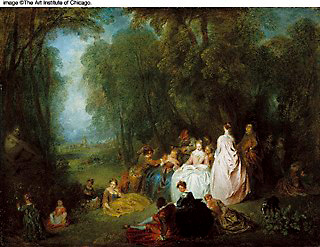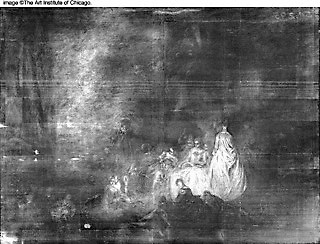Uncovering Watteau
|


|
|
|
Fête Champêtre, 1718/21
Jean-Antoine Watteau (French, 1684�1721)
19 /16 x 25 3/8 in.
Oil on panel
Max and Leola Epstein Collection, 1954.295
X-ray, Fête Champêtre
|
|
|
|
|
|
|
Conservation: An Introduction
Works of art come to the conservation lab in various states of preservation. Each work requires special care to assess the materials and techniques used by the artist, to evaluate the mechanisms of deterioration, and to determine the best methods for preservation and, in some instances, repair. In the category of paintings alone, the range of materials and techniques of fabrication is wide. Paintings have been made using oil paint, egg tempera, wax, protein glue, and, in the modern industrial era, a variety of synthetic media. The range of painting supports includes canvas, wood, metal, stone, masonry, and a variety of modern composites. The mechanisms of deterioration are as varied as the materials themselves and as complex as the techniques used by the artist to make the work of art.
Over time, paintings experience changes in their structure and appearance. For example, a 16th-century oil-on-wood panel may have begun to warp or split or may have suffered insect damage. Another oil painting may have paint losses or tears in its canvas support. More modern paintings, in which artists often used experimental media, may have begun to deteriorate in unexpected ways that can only be understood through in-depth analysis.
One interesting change that takes place in oil paint is that it becomes more transparent with age, revealing pentimenti, hidden figures or objects from an earlier composition underneath the top layers of paint. These pentimenti can be explored with X-radiography and infrared imaging to reveal much about the artist’s process.
Sometimes, works of art of unknown or questioned origin come to the conservation lab for authentication of age and for investigation of their attribution to a specific artist. A number of years ago, an unsigned 18th-century painting came to the conservation lab at the Art Institute for such study. In its early history, the painting, depicting a group of people in a pastoral setting, was attributed to Jean-Antoine Watteau, an artist of the Rococo period much admired and imitated in his own time and now known as the originator of the genre of pastoral painting. At some point in this work’s history, it was reattributed to an artist named Jean Baptiste Pater, Watteau’s only known student. However, further research has led the Art Institute’s curators and conservators to believe that the painting, titled Fête Champêtre (1718/21) (roughly translated, “festivity in the country”), was probably by the teacher rather than the student, or possibly by the two hands working together.
Historical Analysis
Before turning to scientific methods, curators examine a work’s provenance—an established sequence of ownership, which provides a continuous history of a work of art extending all the way back to the person who painted it. When research began on this painting, its known history only extended back to the mid-19th century. After further historical investigation, curators were able to fill in gaps and take its story back to the late 18th century, only about 50 years after Watteau lived and worked. The first known reference to the work in a 1773 auction catalog, in which an individual sketched the appearance of the painting in the margins. The sketch in the 1773 catalog is identical to the painting in the Art Institute’s collection.
Technical Analysis
By combining historical research with analytical techniques, the conservator can look for physical evidence to determine whether a work is consistent with the materials and painting techniques used by a particular artist, which may be critical in establishing an attribution for the work. Generally, there are three steps to technical analysis: surface examination under a microscope and with ultraviolet and raking light; X-radiography and infrared reflectography, which penetrate through the surface of the painting; and sampling, in which small specimens are extracted from the work and analyzed with a range of analytical instruments.
X-radiography makes visible features of the artist’s composition that do not show up on the surface of the painting. This method picks up on the density of the materials in the work of art, creating an image based both on pigments’ elemental properties and the thickness of the layers of paint. Because X-ray images are based on pigment properties, they reveal any repairs that have been made to a work. In modern conservation, a repair in an area of paint loss is called “in-painting,” and this type of repair is generally visible under ultraviolet light and in an X-ray , and with other methods of examination. This is deliberate: Conservators never want to make a repair that might be confused with the original work or that might not be reversible by other conservators in the future.
In an X-ray of the Watteau painting in question (above), several pentimenti are revealed. The figure of a man in a plumed hat appears in the X-ray but is missing from the finished work. In the finished painting, a seated female figure in the middle of the composition, who directs her glance toward the left foreground, originally looked in the opposite direction toward the group of figures in the center of the composition, as evidenced by the X-ray.
Careful study of both images reveals other differences. In the center of the finished composition, a man makes a pass at a woman, who recoils. The X-ray shows that originally there was a figure standing between them. This group of three is similar to a grouping in a known Watteau drawing. A fountain is also visible in the center of the composition in the X-ray but not in the final work. That the artist made these and other adjustments during his process of painting supports the attribution to Watteau, for this was typical of his working method. The character of the brushwork and clarity of the modeling, as revealed in the X-ray, are also typical of Watteau’s work.
One of the more telling pieces of evidence involves the figure of the standing woman seen from the back. The figure is nearly identical to one in Watteau’s most famous paintings, Gersaint’s Shop Sign (1721) and appears in a number of his other works. More significantly, it is intimately related to a figure in Studies of a Woman and Hand (c. 1715-16), a Watteau drawing in the National Museum, Stockholm. Although in the painting under investigation the woman’s dress has been widened at the skirt, microscopic examination establishes that the figure originally corresponded almost exactly to the figure in the Stockholm drawing. A digital overlay of the drawing over the figure in the painting confirms their similarity and further strengthens the painting’s attribution to Watteau.
A detail of the painting was photographed under raking light, which emphasizes the texture of the surface. Under close examination, the photograph revealed that the surface had a very crusty, crackled quality, which is a result of the artist’s particular painting method. Something about how Watteau made and applied his paints has caused many of his works to crack in a unique way. In general, the rule for painting is “fat over lean,” meaning that bottom layers of paint should contain a small amount of medium—such as linseed oil—and subsequent layers should contain a higher proportion of medium to pigment. This allows the bottom layers to dry quickly, while the top layers remain more fluid and dry slowly. If a painter reverses this rule, applying lean over fat, than the bottom layers will remain wet while the layers on top dry. The top layers then flow on the wet layers underneath, and this causes cracks during the drying process.
Many of Watteau’s paintings have this unfortunate condition. It is known that Watteau generally worked by building up multiple layers, and he may have reversed the fat over lean rule or tried to accelerate the working process for convenience. In this painting, as in others, the top colors have separated, revealing other colors beneath. While the unstable crackling of the surface is considered a flaw, it tends to corroborate the authorship of the painting.
All of the methods discussed above—historical research, X-radiography, and photography with raking light—are nonintrusive and not harmful to works of art. Other methods, such as sampling, require the conservator to extract a specimen of material for analysis. Some works of art are in too-pristine condition to be sampled, and when the method is employed caution is used: A small sample will be taken from the edge of the picture or from an area adjacent to already existing damage. When possible, the conservator uses all methods available, including polarized-light microscopy (PLM), X-ray fluorescence (XRF), Scanning Electron Microscope (SEM), Raman spectroscopy, gas chromatography/mass spectroscopy (GC/MS) and X-ray diffraction (XRD) to look at a work of art from multiple viewpoints.
Adapted from a lecture by Frank Zuccari.